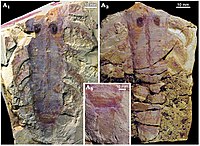| Jianshanopodia Temporal range: Cambrian Stage 3 PreꞒ Ꞓ O S D C P T J K Pg N | |
|---|---|

| |
| Reconstruction of Jianshanopodia decora | |
| Scientific classification | |
| Kingdom: | Animalia |
| Phylum: | †"Lobopodia" |
| Class: | †Xenusia |
| Order: | †Siberiida |
| Family: | †Siberiidae |
| Genus: | †Jianshanopodia |
| Species: | †J. decora Liu et al., 2006 |
Jianshanopodia is a monotypic genus of Cambrian lobopodian, discovered from Maotianshan Shales of Yunnan, China.
Description


 Fossils
Fossils
Jianshanopodia resemble the closely-related siberiid Megadictyon. The head possess a pair of frontal, grasping appendages bear wedge-shaped plates. The pharynx was surrounded by rows of denticles, resembles those of radiodonts and priapulids. The trunk was annulated and possesses a pair of stout legs (lobopods) per body segment. Due to the lack of a complete specimen, the exact number of body segments/leg pair is uncertain. If 12 body segments present, the living animal might grew over 20 cm. Each of the leg was lined up with rows of tubercles and tree-like branches, instead of being tipped with claws as many lobopodians are. The trunk terminated with a large median lobe and a pair of small lateral lobes, forming a fan-like structure. Inside the trunk was a sediment-filled gut surrounded by serially repeated diverticulae.
Jianshanopodia was suggested to be mainly crawled on the sea floor, but could swim with its fan-like tail when necessary. The leg branches might function as external gills. It is thought to be predatory and have sucked up prey with its short 'trunk', consuming food items with its robust mouthparts and gut diverticulae.
Phylogeny
Phylogenetic position of Jianshanopodia according to Pates et al. (2022).
| ||||||||||||||||||||||||||||||||||||||||||||||||||||||||||||||||||||||||||||||||||||||||||||||||||||
References
- ^ Dzik, Jerzy (2011). "The xenusian-to-anomalocaridid transition within the lobopodians" (PDF). Bollettino della Società Paleontologica Italiana. 50 (1): 65–74.
- ^ Jianni Liu; Degan Shu; Jian Han; Zhifei Zhang; Xingliang Zhang (2006). "A large xenusiid lobopod with complex appendages from the Lower Cambrian Chengjiang Lagerstätte". Acta Palaeontologica Polonica. 51 (2): 215–222. Retrieved 2015-03-13.
- ^ Liu, J.; Shu, D.; Han, J.; Zhang, Z.; Zhang, X. (2008). "Origin, diversification, and relationships of Cambrian lobopods". Gondwana Research. 14 (1–2): 277–283. Bibcode:2008GondR..14..277L. doi:10.1016/j.gr.2007.10.001.
- Vannier, Jean; Liu, Jianni; Lerosey-Aubril, Rudy; Vinther, Jakob; Daley, Allison C (2014). "Sophisticated digestive systems in early arthropods". Nature Communications. 5: 3641. Bibcode:2014NatCo...5.3641V. doi:10.1038/ncomms4641. PMID 24785191.
- Smith; Caron (2015). "Hallucigenia's head and the pharyngeal armature of early ecdysozoans" (PDF). Nature. 523 (7558): 75–8. Bibcode:2015Natur.523...75S. doi:10.1038/nature14573. PMID 26106857. S2CID 205244325.
- Vannier, Jean; Liu, Jianni; Lerosey-Aubril, Rudy; Vinther, Jakob; Daley, Allison C. (2014-05-02). "Sophisticated digestive systems in early arthropods". Nature Communications. 5 (1): 3641. Bibcode:2014NatCo...5.3641V. doi:10.1038/ncomms4641. ISSN 2041-1723. PMID 24785191.
- Pates, Stephen; Wolfe, Joanna M.; Lerosey-Aubril, Rudy; Daley, Allison C.; Ortega-Hernández, Javier (2022-02-09). "New opabiniid diversifies the weirdest wonders of the euarthropod stem group". Proceedings of the Royal Society B: Biological Sciences. 289 (1968). doi:10.1098/rspb.2021.2093. PMC 8826304. PMID 35135344.
| Lobopodians | |||||
|---|---|---|---|---|---|
| |||||
| Controversial taxa |
| ||||
| Onychophoran-related taxa | |||||
| Arthropod-related taxa |
| ||||
| Related categories | |||||
| Taxon identifiers | |
|---|---|
| Jianshanopodia | |
This article related to a Cambrian animal is a stub. You can help Misplaced Pages by expanding it. |